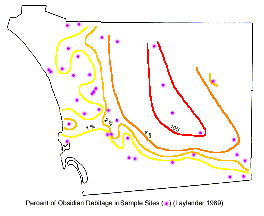Late Prehistoric Obsidian
Obsidian, because of its restricted geological occurrence, visual distinctiveness, and internal chemical homogeneity, is the lithic material that has proved to be most suitable as a basis for the study of prehistoric exchange or long-distance procurement patterns. While not a common material in most San Diego sites, obsidian is at least present in most of the larger assemblages, and it occurs more frequently in Late Prehistoric components than in earlier ones.
The proportion of obsidian within Late Prehistoric assemblages, considered as a function of distance from the obsidian source area or other geographical factors, may shed light on the mechanisms of obsidian exchange and the annual rounds of Late Prehistoric communities:
- Jonathon E. Ericson (1977, 1981) proposed that San Diego sites should exhibit a fairly uniform decline in the proportion of obsidian with increasing distance from the Obsidian Butte source.
- Richard E. Hughes and Delbert L. True (1985:334-335) argued, on the contrary, that no such regular pattern was empirically evident.
- M. Steven Shackley (1981:113) suggested that a more complex pattern was present, with a high frequency of obsidian centered on Cuyamaca, intermediate frequencies to the east and west, and lows to the north and south. (See also Dominici 1984.)
 Don Laylander (1989a:185; Laylander and Christenson 1988a, 1988b) elaborated the pattern, using a larger site sample. His data suggested a dichotomy between a core area that encompasses Warner’s Ranch, Santa Ysabel, Cuyamaca, and Mount Laguna, within which obsidian comprised about 10% of the lithic waste assemblages, and peripheral areas to the west, south, and possibly to the east, where obsidian typically comprised 2% or less of the assemblages.
Don Laylander (1989a:185; Laylander and Christenson 1988a, 1988b) elaborated the pattern, using a larger site sample. His data suggested a dichotomy between a core area that encompasses Warner’s Ranch, Santa Ysabel, Cuyamaca, and Mount Laguna, within which obsidian comprised about 10% of the lithic waste assemblages, and peripheral areas to the west, south, and possibly to the east, where obsidian typically comprised 2% or less of the assemblages.
One hypothesis is that the area of high obsidian frequency may represent an exchange zone, where western groups based on the coast, inland valleys, or foothills met eastern groups based in the desert or on the Colorado River, primarily for the fall acorn harvest, and where the eastern groups traded obsidian to the western groups.
An alternative explanation for the pattern is that the area of high obsidian frequency was merely an area where crystalline volcanic rock and metaquartzite, the primary lithic resources exploited elsewhere in the county, were scarce. The hypothesized exchange zone falls within the portion of the county that lies farthest from these competing local sources of material, although quartz was abundantly available locally.
Another factor may have been differences in the predominant activities taking place in different portions of the county. Obsidian would have been a relatively expensive material to procure, because of its nonlocal sources, but it was valued for its optimal flaking qualities. Its value was best realized in the manufacture of projectile points used for hunting large game or in warfare. The mountain sites may have been in a subregion where deer hunting was more important than elsewhere, or they may have been occupied during seasons (summer and fall) when deer hunting was important. Intergroup disputes over territories or resources may also have been intensified in the mountains, because winter weather probably made these areas only seasonally habitable. Greater use of the bow and arrow at mountain sites may have been reflected in more working of obsidian.
Most of the obsidian in Late Prehistoric San Diego sites seems to be derived from Obsidian Butte in Imperial County, the closest known source area (cf. Hughes and True 1985:332). Some Late Prehistoric obsidian also came from Coso Volcanic Field in the southwestern Great Basin, northeastern Baja California, and other sources.
PROSPECTS
Future archaeological investigations may be able to confirm, refute, or modify the patterns currently observed in the Late Prehistoric distribution of obsidian. They may be able to relate these patterns to such factors as chronology, settlement strategies and contexts, and local technological needs.